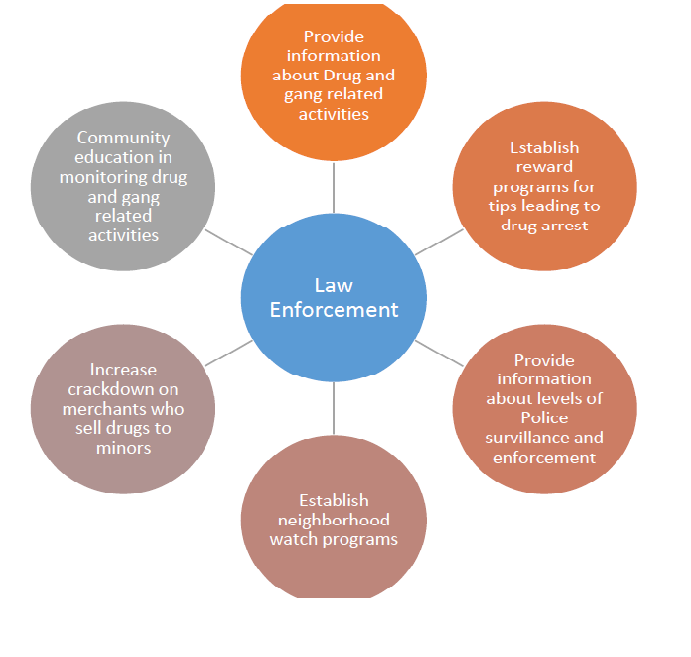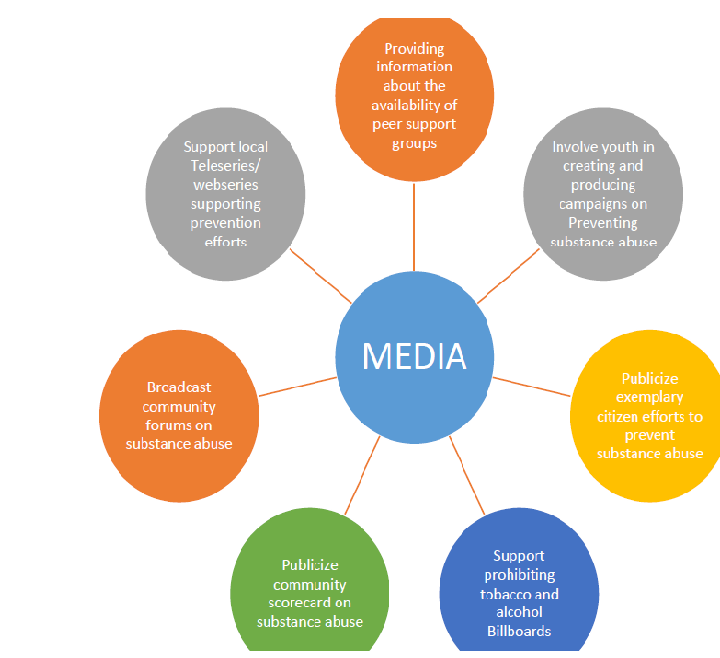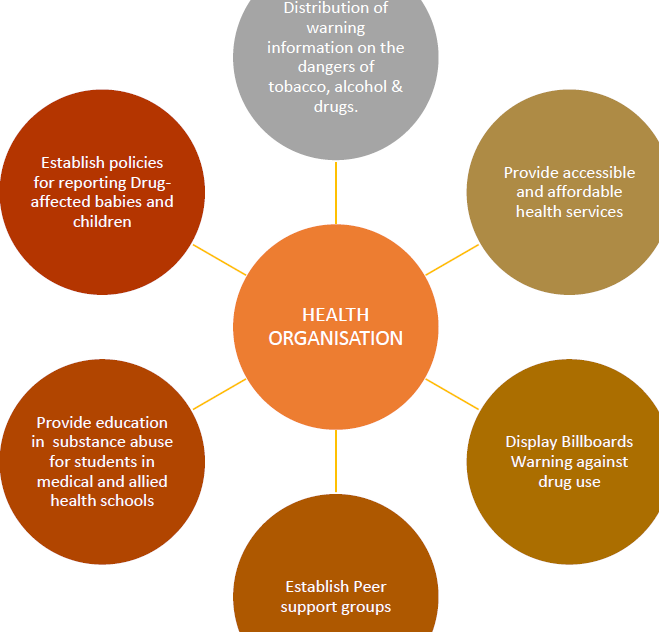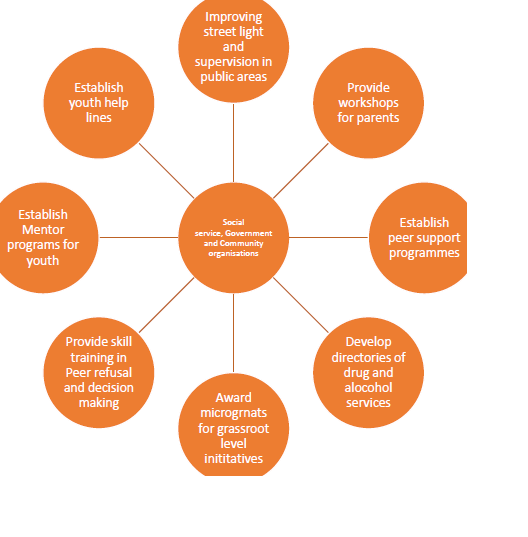Handling Substance Abuse in communities
Handling Substance Abuse in communities
The World Health Organisation (WHO) defines substance abuse as harmful or hazardous use of psychoactive substances, including alcohol and illicit drugs. Psychoactive substance use can lead to dependence syndrome - a cluster of behavioural, cognitive, and physiological phenomena that develop after repeated substance use and that typically includes a strong desire to take the drug, difficulties in controlling its use, persisting in its use despite harmful consequences, a higher priority given to drug use than to other activities and obligations, increased tolerance, and sometimes a physical withdrawal state.
Communities need to plan and implement research-based prevention programs to address Substance Abuse. Actions to be taken by Communities include identifying, assessing needs and community readiness and motivating the community to take action.
Community Plan
Planning usually starts with an assessment of drug abuse and other child and adolescent problems, which includes measuring the level of substance abuse in the community as well as examining the level of other community risk factors. Before, identifying specific problems, it is crucial to ask the following questions:
- Is adolescent/child substance abuse a problem in this community?
- What are the consequences?
- Who is affected?
- How are they affected?
- Are there related issues of concern (e.g. engaging in criminal activities or violence)?
- Are these issues of widespread concern?
These questions will give a lead for the first step that is identification.
Identifying
To assess the level of risk of youth engaging in drug abuse, it is important to:
- Measure the nature and extent of drug abuse patterns and trends
- Collect data on the risk and protective factors throughout the community;
- Understand the community’s culture and how that culture affects and is affected by drug abuse;
- Consult with community leaders, RWA’s, Panchayat and other organisations working in drug abuse prevention, treatment, law enforcement, mental health, and related areas;
- Assess community awareness of the problem; and
- Identify existing prevention efforts already under way to address the problem.
Other data sources and measurement instruments (such as questionnaires) that can help in community planning include the following resources:
- Public access data.
- Public access questionnaires.
- Archival data
- Ethnographic studies.
Other qualitative methods, such as convening focus groups of representatives of drug-abusing sub-populations or key interviews with community officials, can be used to gain a greater understanding of the local drug abuse problem.
Identification and research on the problem of drug abuse in the community is an important process, to determine which steps community will take while planning its intervention strategies. It is only after identifying and assessing the problems and risk factors in the community can we prepare an action plan. Next, an assessment of the community’s readiness for prevention can help determine additional steps that are needed to educate the community before beginning the prevention effort. Then, a review of existing programs is needed to determine gaps in addressing community needs and identifying additional resources.
Readiness of the community
Identifying a serious level of risk in a community does not always translate into community readiness to take action. In order to address this issue, one needs to understand the barriers and sources of resistance in the community. Therefore, it is important to ask the following questions:
- What key individuals or groups might oppose efforts to prevent adolescent substance abuse?
- Can they be involved effectively?
- What other barriers might limit the effectiveness of the prevention initiative?
- How can the barriers and resistance be overcome?
Involving key sectors of the community in substance abuse
The following key stakeholders must be involved in order to develop an effective community plan to address substance abuse:
- Police
- Social service, Government & Community organisation
- Health Service providers (hospitals/doctors/drug and alcohol rehabilitation centres)
- Youth Organisation
- Schools
- Religious institutions
- Media
A few examples of how different stakeholders in the community can prevent substance abuse is given below.
Examples of Involvement of Law enforcers
There are a number of potential changes in law enforcement that might contribute to the mission of reducing substance abuse. Here is an example of the product of planning--a list of changes that might be sought in law enforcement organizations. E.g. the drug de-addiction and rehabilitation centres working under Special Police unit for women and child in New Delhi.

Example of Involvement of Media
There are a number of potential changes in newspapers, radio, and television that might contribute to the mission of reducing substance abuse. Here is an example of the product of planning--a list of changes that might be sought in the media.

Example of Involvement of Health Service Providers
There are a number of potential changes in health service providers that might contribute to the mission of reducing substance abuse. Here is an example of the product of planning--a list of changes that might be sought in hospitals, clinics, public health organizations, health education programs, physicians' offices, and other places where health care is provided.

Examples of Involvement of Youth Organisation
There are a number of potential changes in youth organizations that will contribute to the mission of reducing substance abuse. Here is an example of the product of planning--a list of changes that can be sought in after-school recreational programs, such as Boys and Girls Clubs or the YMCA, Scouting organizations, recreational programs, and cultural organizations.

Prevention activities often involve youth in the promotion of drug-free activities, activities that act as positive alternatives to using drugs. Positive options could include.
- Alternate activities - Arts, Sports, Music
- Future-oriented activities
- Career planning, career fairs
- Financial planning sessions (focus on relevant things: saving up for a car, travel, etc.)
- Presentations from colleges and universities
- Drug-free events
- Battle of the bands
- Sports tournaments
- All-night celebrations with a “no drugs needed” theme
These alternatives are meant to provide youth with things to do that are drug-free. If kids have positive things to do and things that they can be involved in, they will be less likely to use drugs. The desire to “fit in” is a big influence on youth. They are trying to find their own identity, and let go of things they identified with as children. They are bombarded with new information all the time and will make decisions based on this new information and new goals. Teenagers understand that actions have consequences, and that how they behave affects others. Discussions about drug use are incredibly important, and must focus on the consequences of negative and positive decisions. Adults need to provide strong emotional support and be good role models. Once youth are close to or past the age of 18, they are more future-oriented than ever before. They look to adults for new ways to solve problems and make decisions, because soon they will be adults too. Parents have a new chance to positively affect their children.
Example of Involvement of social service, government and community organisations
There are a number of potential changes in social service, government, and community organizations that might contribute to the mission of reducing substance abuse. Here is an example of the product of planning--a list of changes that might be sought in service organizations, including those providing welfare and vocational services as well as drug treatment and aftercare; government agencies, including executive and legislative bodies at local, county, and state levels; and community organizations, including related coalitions, advocacy organizations, self-help groups, neighborhood improvement associations, and neighborhood task forces.

Source : Raising Happy children and providing safe childhoods - A Reader by Ministry of Women and Child Development
Last Modified : 7/2/2023
Provides information about Nasha Mukt Bharat Abhiy...
This topic provides information about Internationa...
